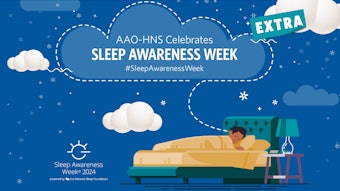Procedures for Pain: Nerve Blocks and Botox for the Otolaryngologist
Nerve blocks and botulinum toxin present an opportunity for otolaryngologists to excel in the treatment of head and neck pain.
Frederick Godley, MD, and Michael Teixido, MD

There are two common mechanisms that cause neurogenic facial pressure or pain. The first is when nerves are affected by compression by a narrow bony foramen or irritated by a blood vessel, as in the case of trigeminal neuralgia. The second and more common etiology is migraine disease, which is a centrally driven sensory processing disorder by way of many potential genetic defects and epigenetic factors.
Migraine disease is characterized by head pain through aberrant trigeminal nerve function, combined with light or noise sensitivity and nausea or vomiting. In other words, migraine disease must affect more than one sensory system as well as the autonomic system by definition. It can present with occasional short-lived symptoms, marked by an intense headache, and believed to be mechanistically secondary to cortical spreading depressions. However, more frequent, and long-lasting presentations of migraine are believed to be caused by neuroplastic changes to the central nervous system, called central sensitization.2 Allodynia is the hallmark of central sensitization, but it likely plays a part in vestibular migraine and other migraine variants. Triggers are thought to initiate migraine symptoms, but some symptoms are spontaneous and do not appear to need a trigger. Ocular migraines are an example of these spontaneous symptoms. The upregulation of the trigeminal nerve, particularly the second branch V2, may generate a phantom sensation of sinus pain or pressure.3 These neuroplastic changes also affect the trigeminal reflex that connects the trigeminal nucleus with the superior salivatory nucleus of the nasal autonomic nervous system. In turn, upregulated parasympathetic nerves dilate venules of the inferior nasal turbinates, causing nasal congestion, and activate mucosal secretory cells, causing rhinorrhea.4 It has been reported that more than 50% of patients with migraine have at least one cranial autonomic symptom.5
Migraine disease is known to cause visual, olfactory, and auditory hallucinations, and one can speculate that this phenomenon could affect the trigeminal nerve and cause phantom sensations of nose and sinuses that could be easily mistaken for infectious or inflammatory rhinosinusitis.
The mechanism of nerve blocks is not fully known. However, the fact that there is immediate pain relief that lasts hours or days beyond the known efficacy of a local anesthetic suggests that nerve blocks have an additional effect on the sensitivity of a sensory nerve by way of a diffuse noxious inhibitory control mechanism. Further, that repeated sphenopalatine6, trigger point7, greater occipital8 nerve blocks can provide relief from chronic pain syndromes for months suggests that they break a cycle or influence the neural environment sufficiently to return neuroplastic changes to a more normal level of neural activity or sensitivity.
A common target for nerve blocks is the sphenopalatine ganglion (SPG), a large nerve center through which both trigeminal and autonomic nerves pass. Clinicians can directly inject this ganglion through the nose or via the greater palatine canal but will more commonly apply topical anesthetics intranasally because the latter technique is more easily tolerated by patients and carries less risk. There are also several nerve blocks of specific facial sensory branches: preauricular, supraorbital, supratrochlear, infraorbital, zygomaticofacial, and zygomaticofrontal.
Another common procedure for neck pain and headaches is the greater occipital nerve block (GON). Localized nerve blocks affect other parts of the head because both trigeminal and cervical nerves originate from the common large brainstem trigeminocervical nucleus. Blocking just one side of the occipital nerve complex can alleviate pain not only locally in the back of the head and neck but across the meninges and facial structures.9 A review of clinical trials showed a reduction in headache severity and frequency in 35%-68% of patients—a single GON block reduced headache symptoms for up to four weeks.10 This nerve block may lead to a long-lasting reduction of chronic pain by reversing chronic central sensitization.11,12 It may also be effective for cervicogenic headaches, cluster headaches, prolonged migraine aura, status migrainosus, post-dural puncture headache, and occipital neuralgia with low risk of complication.13
In most cases, nerve blocks require only small quantities of local anesthetics with or without epinephrine. The choice of local anesthetic does not matter. A corticosteroid can also be added—although it is unclear if there is sufficient added value to offset the risks of fat absorption and alopecia. The risks of using a local anesthetic are generally mild and manageable, including bleeding and hematoma, infection, and allergic reaction to the anesthetic. Patients might feel dizziness, weakness, or lightheadedness. Local anesthetics can sting, not only because of the stretching of nerve fibers in the soft tissue, but also the acidity of the solution. This is necessary for the stability and shelf life of the anesthetic, but buffering the anesthetic with sodium bicarbonate can reduce the pain injection. Depending on the location of the injection, the patient should be warned of a possible transient droopy eyelid, stuffy nose, red eye, or redness in the face. For SPG blocks with topical anesthetic, warn the patient that the anesthetic will cause a bitter taste and temporary numbness of the throat that can make it difficult to swallow normally. Nerve blocks are performed in the office, require consent, and can be billed as procedures.
Some surgeons reason that if nerve blocks are effective, a more permanent solution is to perform nerve decompression or ablation of the supraorbital and supratrochlear nerves, zygomaticotemporal nerves, nasal branches of the trigeminal nerve, greater occipital or the third occipital nerves, auriculotemporal nerve, and lesser occipital nerve. Concerns remain about the unreliable results of these procedures and the risk that patients may have areas of permanent numbness.
A variation on this logic is applied to the concept that nerves can be irritated when in contact with each other and that this phenomenon occurs within the nose. The idea is that by identifying contact points and achieving temporary pain relief with the application of a topical anesthetic, one can relieve pain and headaches by separating these contact points. Despite favorable clinical reports7, there is still the need to perform more rigorous studies to prove the efficacy of contact point surgery.
Finally, there is a less controversial procedure in which botulinum toxin is used to relieve pain. While the mechanism of this agent was not well understood at first, it is now clear that botulinum toxin is absorbed and transported within sensory nerves. It causes pain relief by blocking the binding and release of intracellular vesicles of the major pain neurotransmitters substance P, glutamate, and calcitonin gene-related peptide, and the expression of cell membrane receptors.14 Otolaryngologists who are already familiar with the use of botulinum toxin to relieve muscle spasms or for cosmetic use, should feel comfortable applying those techniques to the cervical and trigeminal nerve branches. Botulinum toxin is also valuable in treating temporomandibular disorder pain.
According to an informal survey of 395 otolaryngologists carried out by one of the current authors (Dr. Godley) in 2023, only a third of respondents felt that the management of migraine does not fall within the specialty (Figure 1). More than 50% of respondents stated that they were already managing migraine disease (Figure 2). Yet, these effective and reimbursable office procedures (i.e., nerve blocks and botulinum toxin) are not being used frequently (Figure 3). Only 12% of those surveyed used SGP nerve blocks, with 4% using them more than four times per month. Only 10% used other nerve blocks, with 2% using them more than four times per month. Finally, 17% of those surveyed used botulinum toxin to control pain, with 5% employing this treatment more than four times per month. A majority (92/168 or 55%) of respondents who do not manage their migraine patients gave insufficient training as one of their reasons. These highly effective treatments for pain remain an opportunity for otolaryngologists to meet an unmet need.
 Figure 1
Figure 1
 Figure 2
Figure 2
 Figure 3
Figure 3
References
- Schulz, Kristine A., Elnaz Esmati, Frederick A. Godley, Claude L. Hill, Ashkan Monfared, Michael Teixido, Debara L. Tucci, and David L. Witsell. “Patterns of Migraine Disease in Otolaryngology: A CHEER Network Study.” Otolaryngology–Head and Neck Surgery 159, no. 1 (2018): 42–50. https://doi.org/10.1177/0194599818764387.
- Bak, Myeong Seong, Haney Park, and Sun Kwang Kim. “Neural Plasticity in the Brain during Neuropathic Pain.” Biomedicines 9, no. 6 (2021): 624. https://doi.org/10.3390/biomedicines9060624.
- Bouhassira, D., N. Danziger, N. Atta, and F. Guirimand. “Comparison of the Pain Suppressive Effects of Clinical and Experimental Painful Conditioning Stimuli.” Brain 126, no. 5 (2003): 1068–78. https://doi.org/10.1093/brain/awg106.
- Elsheikh, Mohamed Nasser, and Hala Mahfouz Badran. “Dysautonomia Rhinitis: Associated Otolaryngologic Manifestations and Characterization Based on Autonomic Function Tests.” Acta Oto-Laryngologica 126, no. 11 (2006): 1206–12. https://doi.org/10.1080/00016480600704072.
- Danno, Daisuke, Johanna Wolf, Kumiko Ishizaki, Shoji Kikui, Koichi Hirata, and Takao Takeshima. “Cranial Autonomic Symptoms in Migraine Are Related to Central Sensitization: A Prospective Study of 164 Migraine Patients at a Tertiary Headache Center.” BMC Neurology 22, no. 1 (2022): 89–89. https://doi.org/10.1186/s12883-022-02610-8.
- Ho, Kwo Wei David, Rene Przkora, and Sanjeev Kumar. “Sphenopalatine Ganglion: Block, Radiofrequency Ablation and Neurostimulation - a Systematic Review.” The Journal of Headache and Pain 18, no. 1 (2017): 118–118. https://doi.org/10.1186/s10194-017-0826-y.
- Vincent AJPE, van Hoogstraten WS, Maassen Van Den Brink A, van Rosmalen J, Bouwen BLJ. “Extracranial Trigger Site Surgery for Migraine: A Systematic Review with Meta-Analysis on Elimination of Headache Symptoms.” Front Neurol. 2019 Feb 14;10:89. doi: 10.3389/fneur.2019.00089. PMID: 30837930; PMCID: PMC6383414.
- Madore, DO, Samuel, et al. “The Use of Occipital Nerve Blocks & Trigger Point Injections in Headaches with Occipital Tenderness.” Osteopathic Family Physician, vol. 9, no. 1, Jan. 2017, https://ofpjournal.com/index.php/ofp/article/view/483.
- Liu, Aijun, Yongcheng Jiao, Huijun Ji, and Zhiwen Zhang. “Unilateral Occipital Nerve Stimulation for Bilateral Occipital Neuralgia: A Case Report and Literature Review.” Journal of Pain Research 10 (2017): 229–32. https://doi.org/10.2147/JPR.S125271.
- Chowdhury, Debashish, and Ankit Mundra. “Role of Greater Occipital Nerve Block for Preventive Treatment of Chronic Migraine: A Critical Review.” Cephalalgia Reports 3 (2020): 251581632096440. https://doi.org/10.1177/2515816320964401.
- Ashkenazi, Avi, and William B. Young. “The Effects of Greater Occipital Nerve Block and Trigger Point Injection on Brush Allodynia and Pain in Migraine.” Headache: The Journal of Head and Face Pain 45, no. 4 (2005): 350–54. https://doi.org/10.1111/j.1526-4610.2005.05073.x.
- Viganò, Alessandro, Maria Claudia Torrieri, Massimiliano Toscano, Francesca Puledda, Barbara Petolicchio, Tullia Sasso D’Elia, Angela Verzina, et al. “Neurophysiological Correlates of Clinical Improvement after Greater Occipital Nerve (GON) Block in Chronic Migraine: Relevance for Chronic Migraine Pathophysiology.” The Journal of Headache and Pain 19, no. 1 (2018): 73–73. https://doi.org/10.1186/s10194-018-0901-z.
- Stern, Jennifer I., Chia‐Chun Chiang, Narayan R. Kissoon, and Carrie E. Robertson. "Narrative review of peripheral nerve blocks for the management of headache." Headache: The Journal of Head and Face Pain 62, no. 9 (2022): 1077-1092. https://doi.org/10.1111/head.14385
- Kumar, Raj. “Therapeutic Use of Botulinum Toxin in Pain Treatment.” Neuronal Signaling 2, no. 3 (2018): NS20180058–NS20180058. https://doi.org/10.1042/NS20180058.




















